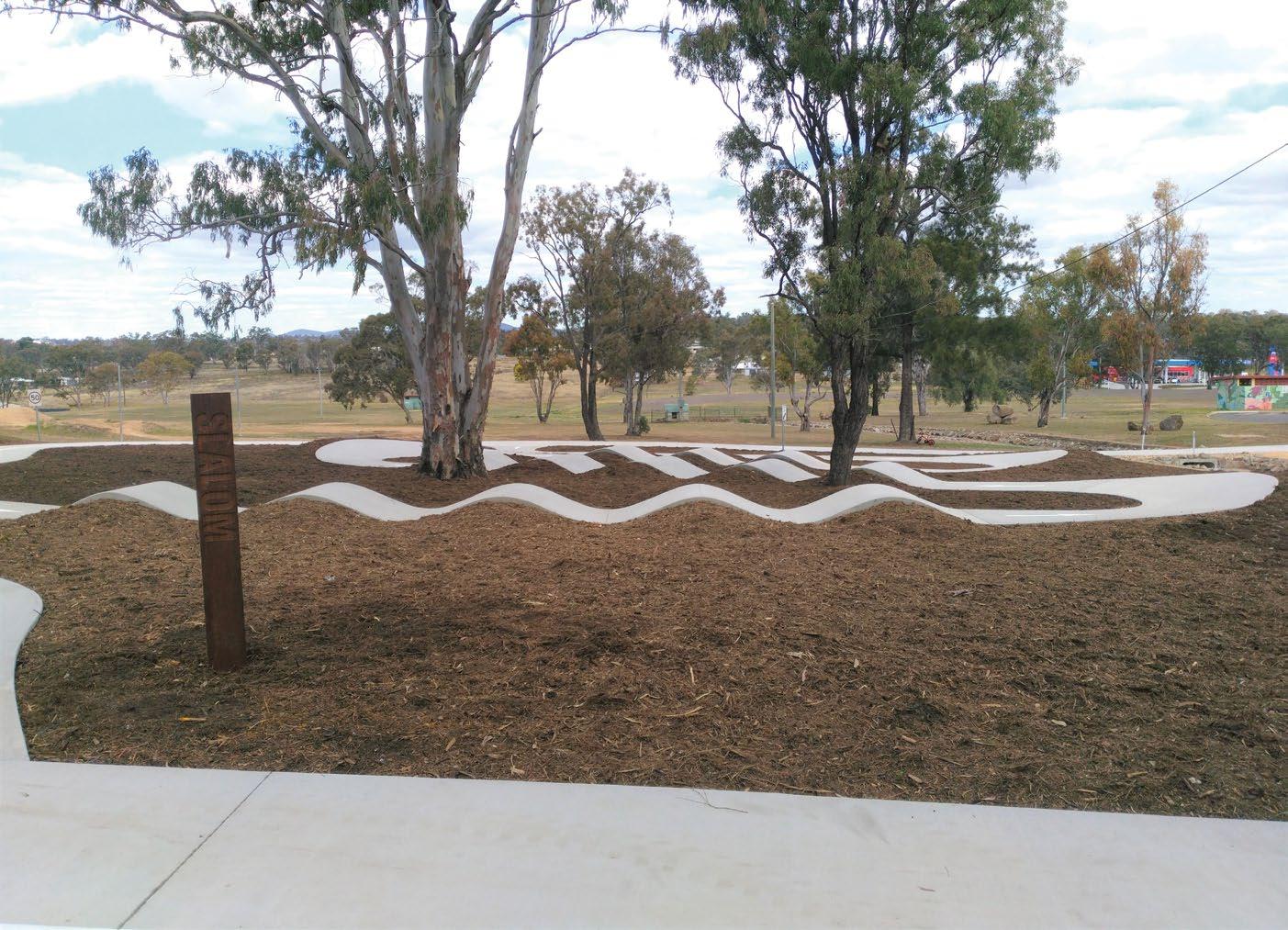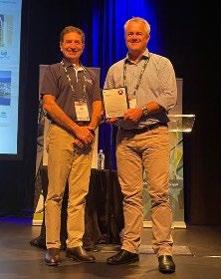
7 minute read
Learn to Ride Park - Southern Downs Regional
SOUTHERN DOWNS – ONE STEP AHEAD!
2020
ROAD SAFETY AWARD WINNER!
James Varughese
Before the COVID-19 pandemic, Southern Downs Regional Council embarked on a project to get kids outside and start exercising! The idea was to build a Learn to Ride Park to help get kids active and provide a safe area where they can learn to ride their bikes. With such emphasis now placed on keeping active during isolation, Southern Downs proved to be one step ahead of the crowd by building this new, fun facility.
The idea of a Learn to Ride Park in Australiana Park in Warwick (two hours south-west of Brisbane) has been on the wish list since 2007 when the former Warwick Shire Council adopted a Master Plan for Australiana Park. Already existing in the park were a velodrome and a BMX track, so a Learn to Ride facility would fit well with the other cycling infrastructure.
As the new construction of a recreational facility of this nature may not rate highly against other local infrastructure projects funded by ratepayers, Southern Downs Regional Council sought grant funding for the project. Success came through the Queensland Government’s Works for Queensland program Round 3, which allocated $300,000 for the project.
Designing such a specific product was not within council’s expertise, so it outsourced the design services to Adaptive Cycle Pty Ltd trading as 8LA. One of its Directors, Gerard McCormick was delighted to be awarded the tender to design and construct the Learn to Ride Park in Australiana Park in December 2019.
The vibe of Australiana Park at that time was quite tired and seemed to be a place where travellers would briefly stop for a comfort break and then be on their way. Council initially allocated the north-western corner of the park for the Learn to Ride facility as there was sufficient space for it in that area. The southern two-thirds of the park were contaminated as the park was constructed on a former landfill site; therefore disturbing the surface of that area was not desired.
When council staff met with Gerard McCormick onsite in January 2020, a totally new vision began. Gerard’s enthusiasm to place the Learn to Ride facility on the north-western corner, beside the Cunningham Highway to attract attention, was immediately well received.
Picnic shelters and a playground were already located in the area for the Learn to Ride Park to weave around. A disused water feature that visually and physically divided the park would be overcome by installing a bridge to reconnect the eastern side with the accessible western side of the park.
With the ideas and suggestions from the landscape designer, the concept of a dull, flat concrete path with the odd Stop or Give Way sign had disappeared!
Design and Consultation Phase
Within one week of the initial site inspection, council had a concept sketch on the table. The concept included elements such as a water hazard, a bridge, a railway level crossing and a slalom track with whoops and berms. Standard road features included a roundabout, stop and give way intersections, one-way roads, pedestrian crossings and rural features such as a cattle grid and gravel road with corrugations. The need for an area where small
Learn to Ride Park in Australiana Park, Warwick.


Site - before. Site - before.

Existing disused water feature infrastructure.

Aerial view of the completed - Bandy Bandy.
children could learn to ride their bikes was not lost in the hype – a specific track in the shape and colours of the locally-found Bandy Bandy snake was included in the design. Numbers were also added to increase the interest for the young riders.
The concept was presented to the councillors, who eagerly embraced the concept but requested that feedback be sought from the community. At the time, restrictions on gatherings were in place due to COVID-19. Instead of presenting the concept to the community at a public meeting as council would normally have done, the feedback was gathered online. Social media played an important role in getting the message out to the community to provide their feedback electronically.
Council sought individual feedback of key community members, such as a 10-year-old girl who had a year earlier written to the Mayor requesting that a Learn to Ride Park be built in Australiana Park. The concept design was provided electronically to the young person’s mother and then a teleconference was held with relevant council staff, a landscape designer, plus the young person and her mother. One of the key outcomes of this community engagement was the young person’s request that a manually operated traffic light be included as an important feature for the facility.
Council also engaged with a member of Landcare to gather information about the appropriate planting species to feature within the garden sections of the Learn to Ride Park. As the site was particularly arid, sloping and in the current drought, the selection of drought-hardy plants was vital. The species selected were Bottle Trees, Morton Bay Ash and Flax Lilly.
To keep the facility’s future maintenance to a minimum, the paths were constructed with concrete and large areas of the facility were mulched with stones or forest mulch.
Once the community feedback was collated, which was very positive, council staff sought to


Manually operated traffic light. Recycled manhole covers.


Roundabout. The Black Stump.


Railway level crossing. Simulated dry creek crossing.
bring the concept with feedback back to the councillors for adoption. At the time, council was entering a Caretaker Period, which resulted in a necessary setback to the project timeline.
After the new council had been sworn in, the concept with feedback was presented and met with the same enthusiasm as was shown by the former council.
Construction Phase
Adaptive Cycle t/a 8LA engaged Naturform for the construction element of the Learn to Ride Park. Site possession was handed over in early June 2020 and progressed smoothly. Particular care was taken by the contractor when performing surface earthworks to ensure that no debris from the former landfill was uncovered.
Recycled items from council’s depot became feature elements within the Learn to Ride Park, including rusty stormwater covers that now appear as wheels within the roundabout garden, cracked concrete manhole covers that have started a new existence as bike racks, old signposts with coloured caps used as bollards but appearing as flowers, unused culverts have now become a pedestrian/cycle bridge and an old tree stump has been strategically placed within the Learn to Ride Park for when riders go out ‘beyond the black stump’ to the top end of the track.
With the railway line running along the north of Australiana Park, the inclusion of a railway level crossing was embraced by Queensland Rail, who kindly donated rail line for the crossing.
Discussions are being held with the local Southern Downs Steam Railway to potentially incorporate another rail feature item at the level crossing.
A minor concept design change to the construction issue
plans is the amendment to all tracks being constructed out of concrete for longevity. This provided a challenge for the gravel road with corrugations. The solution was to rock salt the concrete path to provide a gravel texture and simulate the corrugations and cattle grids into the concrete. Custom made trowels were fabricated to achieve these concrete effects.
In cooperation with the Queensland Government’s road safety promotion to not cross flooded roads, the inclusion of “If it’s flooded, forget it” signage at the simulated dry creek crossing to help raise awareness of the dangers of crossing flooded roads.
For more adventurous or skilled, older riders a slalom track with whoops and berms has proved to be a real drawcard.
The Learn to Ride Park is enjoyed by young and old riders. The construction of the facility has successfully brought new life back to Australiana Park. Southern Downs Regional Council hopes that park continues to be a wellutilised community facility for years to come.
ABOUT THE AUTHOR
James has worked in the engineering field in the Middle East and Australia for more than 15 years. He has gained much experience as a local government Civil Engineer and has an extensive background in contract administration, project management and construction techniques. As a RPEQ, James exhibits practical knowledge in professional engineering principles, skills and values.

Construction of whoops.

Completed slalom with whoops and berms.









